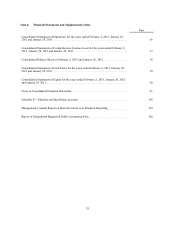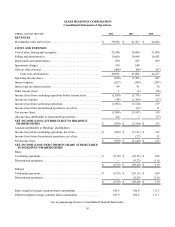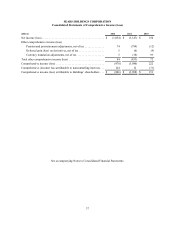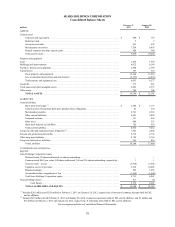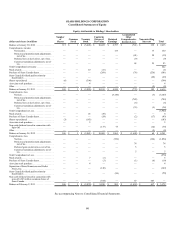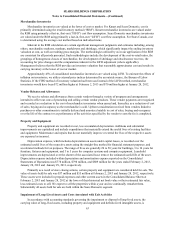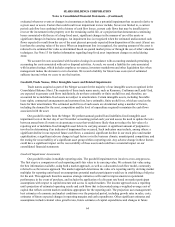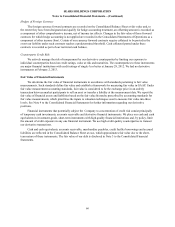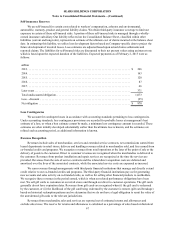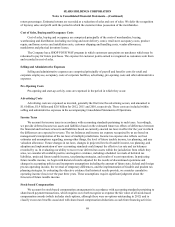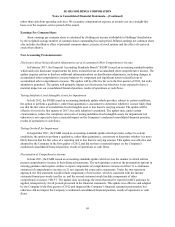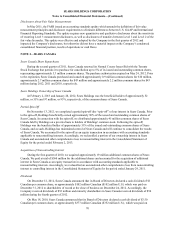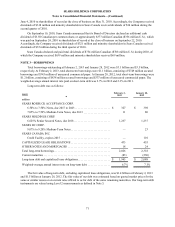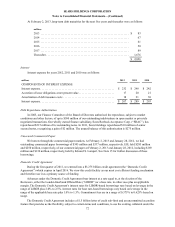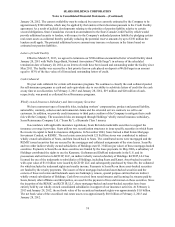Sears 2012 Annual Report Download - page 64
Download and view the complete annual report
Please find page 64 of the 2012 Sears annual report below. You can navigate through the pages in the report by either clicking on the pages listed below, or by using the keyword search tool below to find specific information within the annual report.SEARS HOLDINGS CORPORATION
Notes to Consolidated Financial Statements—(Continued)
64
evaluated whenever events or changes in circumstances indicate that a potential impairment has occurred relative to
a given asset or assets. Factors that could result in an impairment review include, but are not limited to, a current
period cash flow loss combined with a history of cash flow losses, current cash flows that may be insufficient to
recover the investment in the property over the remaining useful life, or a projection that demonstrates continuing
losses associated with the use of a long-lived asset, significant changes in the manner of use of the assets or
significant changes in business strategies. An impairment loss is recognized when the estimated undiscounted cash
flows expected to result from the use of the asset plus net proceeds expected from disposition of the asset (if any) are
less than the carrying value of the asset. When an impairment loss is recognized, the carrying amount of the asset is
reduced to its estimated fair value as determined based on quoted market prices or through the use of other valuation
techniques. See Note 13 for further information regarding long-lived asset impairment charges recorded during
2012.
We account for costs associated with location closings in accordance with accounting standards pertaining to
accounting for costs associated with exit or disposal activities. As such, we record a liability for costs associated
with location closings, which includes employee severance, inventory markdowns and other liquidation fees when
management makes the decision to exit a location. We record a liability for future lease costs (net of estimated
sublease income) when we cease to use the location.
Goodwill, Trade Names, Other Intangible Assets and Related Impairments
Trade names acquired as part of the Merger account for the majority of our intangible assets recognized in the
Consolidated Balance Sheet. The majority of these trade name assets, such as Kenmore, Craftsman and Lands' End,
are expected to generate cash flows indefinitely, do not have estimable or finite useful lives and, therefore, are
accounted for as indefinite-lived assets not subject to amortization. Certain intangible assets, including favorable
lease rights, contractual arrangements and customer lists, have estimable, finite useful lives, which are used as the
basis for their amortization. The estimated useful lives of such assets are determined using a number of factors,
including the demand for the asset, competition and the level of expenditure required to maintain the cash flows
associated with the asset.
Our goodwill results from the Merger. We perform annual goodwill and indefinite-lived intangible asset
impairment tests at the last day of our November accounting period each year and assess the need to update the tests
between annual tests if events or circumstances occur that would more likely than not reduce the fair value of a
reporting unit or indefinite-lived intangible asset below its carrying amount. A significant amount of judgment is
involved in determining if an indicator of impairment has occurred. Such indicators may include, among others: a
significant decline in our expected future cash flows; a sustained, significant decline in our stock price and market
capitalization; a significant adverse change in legal factors or in the business climate; unanticipated competition; and
the testing for recoverability of a significant asset group within a reporting unit. Any adverse change in these factors
could have a significant impact on the recoverability of these assets and could have a material impact on our
consolidated financial statements.
Goodwill Impairment Assessments
Our goodwill resides in multiple reporting units. The goodwill impairment test involves a two-step process.
The first step is a comparison of each reporting unit's fair value to its carrying value. We estimate fair value using
the best information available, using both a market approach, as well as a discounted cash flow model, commonly
referred to as the income approach. The market approach determines the value of a reporting unit by deriving market
multiples for reporting units based on assumptions potential market participants would use in establishing a bid price
for the unit. This approach therefore assumes strategic initiatives will result in improvements in operational
performance in the event of purchase, and includes the application of a discount rate based on market participant
assumptions with respect to capital structure and access to capital markets. The income approach uses a reporting
unit's projection of estimated operating results and cash flows that is discounted using a weighted-average cost of
capital that reflects current market conditions appropriate for the reporting unit. The projection uses management's
best estimates of economic and market conditions over the projected period, including growth rates in sales, costs,
estimates of future expected changes in operating margins and cash expenditures. Other significant estimates and
assumptions include terminal value growth rates, future estimates of capital expenditures and changes in future



